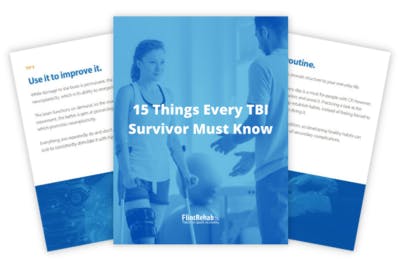No products in the cart.
No products in the cart.
No products in the cart.
No products in the cart.
Home » Neurological Recovery Blog » Traumatic Brain Injury » TBI Side Effects » Tics After Head Trauma: Causes, Diagnosis, and Treatment
Last updated on May 27, 2020

Tics after head trauma can cause a person to make sudden, repetitive movements or vocalizations. These movements are involuntary, although they do not always appear that way.
This article will discuss the possible causes and symptoms of tics after a head injury, plus some helpful ways to manage them.
Tics are one of several post-traumatic movement disorders that can occur after severe head trauma. According to most estimates, these disorders can affect anywhere between 13% to 66% of TBI patients.
The exact cause of tics after a brain injury is unknown, but there are several possible factors. These include:
Most tics develop within the first few weeks after a head injury, but some have been known to appear as late as one year post-injury.
Tics are primarily involuntary movements. However, some tics are accompanied by premonitory sensory urges (uncomfortable feelings you get before a tic that may be improved by certain movements). Many patients with tics describe it as the feeling you get right before you sneeze.
There are two main types of tics that can occur after head injury: motor tics and vocal tics. We will discuss both in more detail in the sections below:

Vocal tics after head trauma can vary in their complexity. Most involve short, meaningless sounds such as grunts or throat clearing.
But some vocal tics are so complex that they do not sound unintentional. For example, some can actually cause a person to hum or sing their favorite tune. Others, such as echolalia, cause the patient to repeat whatever phrase they just heard from another person.
Other types of vocal tics have less socially acceptable effects. Perhaps the most famous type of vocal tic, known as coprolalia, causes a person to involuntarily exclaim obscene language. Often these vocal tics are spoken in a louder tone or different pitch than normal conversational speech.
This type of vocal tic is a common symptom of Tourette’s syndrome, but it can also occur after head trauma.
Vocal tics, like motor tics, are involuntary. But because they tend to involve words, they can cause the person to experience social stigma and psychological distress.
Motor tics after head trauma can also vary in their presentation and can affect any muscle or part of the body. However, most motor tics develop in a rostral-caudal manner.
This means that tics involving facial and head movements typically emerge first. Then, as time passes, tics involving the torso and extremities may also appear.
Some examples of motor tics include:
Sometimes tics can involve multiple, sequential movements that appear purposeful, such as making rude faces or gestures. However, as complex as these movements seem, they are involuntary.

In rare cases, head injury patients can develop obsessive-compulsive disorder (OCD). This is an anxiety disorder that causes intrusive thoughts. Patients with OCD often perform certain compulsive behaviors that help silence these thoughts.
These behaviors, however, can look almost indistinguishable from the tics caused by movement disorders. Therefore, finding a treatment plan can be difficult. Medication used for OCD often does not work for tics and vice versa, which is why it is important to get the right diagnosis.
In general, tics after head trauma are brief and lack purpose, whereas compulsions are more intentional and complex. However, that is not always the case. Sometimes tics can also manifest as complex actions.
Compulsions are also usually made in response to anxiety or fear. Tics, on the other hand, are not usually accompanied by anxiety and are mostly involuntary.
Still this distinction is not always easy to apply, because it’s not always clear why someone is making a repetitive movement. Therefore, it is helpful to schedule an evaluation by a psychologist when tics occur to determine whether OCD is involved.

The most effective form of treatment for tics after head trauma is a combination of cognitive-behavioral therapy and medication.
Specifically, the type of therapy that most tic patients have success with is habit reversal training. Habit reversal training involves four main steps:
The guiding principle behind this treatment is a phenomenon called neuroplasticity. Neuroplasticity means that, with enough practice, a person can rewire their neural connections and change their behavior.
Therefore, even problems like tics and impulsive behaviors after head trauma can be overcome. You just need to learn how to rewire your brain.
Head trauma can trigger involuntary, repetitive actions known as tics. These behaviors can manifest as verbal or motor tics and can range from simple motions to complex actions.
Obsessive-compulsive disorder can cause problems that look a lot like tics, but requires a completely different treatment protocol. Therefore, patients should consult with a psychologist before beginning treatment.
Sometimes tics after a head trauma will resolve on their own. If the tics do not go away, or if they cause too many problems, habit reversal training can help you manage them.
With the right treatment, you can begin to reduce the frequency of your tics and gain back control of your behavior again.

If you like our content, you’ll love our ebook and newsletters! Get instant access to our TBI recovery tips ebook with 20 pages of helpful advice by signing up below.
You’ll also receive our emails that share survivor stories and more useful TBI recovery tips, which you can opt out of at any time. (We know you’ll love them, too.)
We will never sell your email address, and we never spam. That we promise.


Time with a speech therapist is extremely valuable during recovery, especially if you struggle with communication, critical thinking, or memory after brain injury. Insurance typically covers speech therapy for a fixed amount of time. But once it’s over, recovery is in your hands.
That’s why a team of neuroscientists and clinicians from Boston University created the CT Speech & Cognitive Therapy app. Designed for those recovering from stroke, TBI, or living with neurological conditions, the app contains over 100,000 cognitive exercises that are all available right from your phone or tablet. That’s like having a speech therapist by your side whenever you want!
This app is the perfect fit if you want to improve your speaking, memory, or general mental sharpness. And, it’s affordable at just $29.99/month!
“For the past 6 months, my son has used the app about three times a week. The app is like a virtual therapist, it’s very easy to use, and it gives him immediate feedback.
He now understands things faster, can make decisions with less hesitation, has improved recognition of words, and his confidence is higher. I also find it easy to get in touch with customer service; they pleasantly help out. The whole experience has been great.”
— Miriam
With the CT App, you can get the guidance you need right from your phone or tablet. You can use it on your own or in between sessions with your speech therapist.
Whether you struggle with aphasia, memory loss, or critical thinking, the CT Speech & Cognitive Therapy App can help.
“The CT app has helped me gather my confidence by building on and reinforcing old forgotten skills. It helps to see my percentages increase, and work harder when they decrease. It’s very self-motivating.” -Kathryn
We are confident that this app will help improve your speech and cognitive function after brain injury. Like our recovery tools, the CT App is also covered by our 30-day money-back guarantee.

Do you know these 15 TBI recovery tips?
Get a free copy of our ebook 15 Things Every TBI Survivor Must Know. Click here to get instant access.
Grab a free rehab exercise ebook!
Sign up to receive a free PDF ebook with recovery exercises for stroke, traumatic brain injury, or spinal cord injury below: